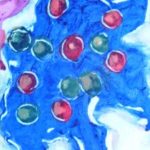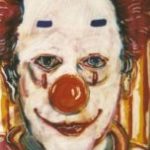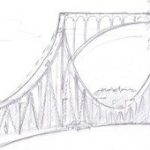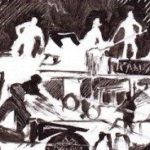Twisted Olympian
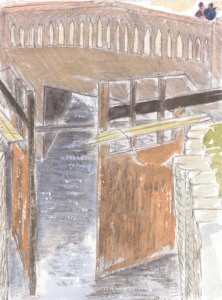
It was a natural part of childhood to have glorious intention and be always making or fixing something. When we were not making a football out of paper and string we were mending a puncture on the bike. We could be extending the barrel of a six-shooter with the cardboard and silver paper out of an empty cigarette pack, or stitching the school bag with the spool of strong brown thread belonging to ‘me da,’ that no one was to touch.
If you wanted to play hoops, you looked for a bicycle wheel. You could find a good rim in the canal under Sally’s Bridge. Or you may have to travel as far as the lock gates at Inchicore. It might be attached to a half mangled bicycle frame. You’d need sharp eyesight to spot your prize among the cast shadows and shimmer that played tricks on your concentrated squinting. Then, you’d have to hatch a plan to recover it. A strong wire hook tied to rope usually did the trick. Also, among the reeds was the rest of the wreckage dumped in by a neighbour during an after dark excursion to the canal. It’s the same canal that Christy Browne ended up being thrown into unceremoniously one day.
His pals wanted to see if he could swim. The irony of it is he couldn’t walk. ‘That’s the little brats for ya, always experimenting, trying to create an Olympic champion swimmer out of a twisted wreck’. Now, that takes imagination. But isn’t that the essence of life right there? In fact, that’s what we’re here for, to create the best we can out of the available materials. It’s not a failure to try. Only is it a failure to not imagine it possible. The tragedy would be to not have glorious intention.
Transforming a rusty old bicycle wheel into a champion hoop. And a champion it could be if I trimmed out the spokes till there was only three left to hold the center in place. That makes it lighter. The sparse spokes give that extra advantage to propel the hoop into a sudden spin with a carefully chosen stick. It needs to be not too long, not too short, not too thin, not too chubby. Light and strong and flexible, now that’s the ticket.
Children know what they know instinctively. They don’t need telling. Always they’re inventing, creating and using their initiative. They have glorious intention and they succeed in bringing their ideas to life effortlessly. The young ones are incredulous if sabotage wrecks their grand plans. Usually this happens through a doubting adult. The child always knows the impossible is within arm’s reach of their glorious intention. Not once do they question their right to success. At the same time they are not attached to the outcome, knowing their inventive minds can quickly turn over another plan, another idea.
It’s only when they encounter adult doubt and lack of initiative, suspicion and cynicism, do they put on the brakes to their infallibility. Adults should know more than children know and so, children trust them. In their efforts to absorb more knowledge, they get caught up in the adult world of information and find out that this is knowledge. But of course, this is not knowledge. It’s information disguised. Children already have access to all the knowledge they need.
Most adults on the other hand, have lost their access to innate knowledge. They replace it with their brain’s intelligence and pontificating. It’s a poor substitute, devoid of imagination. By the time children find this out, it’s too late. Their hearts harden. This eventually undoes enthusiasm, the bonding agent for a child’s exploring in life. Then, reason applies where heretofore there was bold adventure. A child hears ‘take care, watch out’ and eventually, with repeated warnings, this penetrates into the psyche. Doubt gradually infiltrates the child’s fuel and over time it manifests into a full plague. This pestilence rots to the core any enthusiasm for adventure.
Now safety becomes the main issue and everybody measures life by the insurance rod. We seek guarantees and if they’re not forthcoming, compensation for what is lost. We dull our lives so completely. We smile at little children in their play not realizing the damage we are doing to these inventive creators of a magic world. Prodded are their aerodynamic creations and inventions with stubby criticizing tools that lack subtlety and grace.
Predictable copy presents for ideas like a bandaged thumb jutting through the slender nimble fingers of a pianist. We hold on for dear life to our grotesque institutions. Here are our value torn religions, our double couched judicial systems, our stitch and bandaged health services, our brain bashing educational systems, our jellyfish governments. We’re sitting on a powder keg, pulling heavily on fat cigars, oblivious to the blanked out cries of our disenchanted and disenfranchised, indigenous and ethnic worlds.
We’ve turned into a race of critical spectators. We are content to let everybody else make decisions for our lives. In the process, we’ve lost our natural child like abilities to fix and make. No longer do we hone glorious intention through our natural invention, instinct, insight, innovation and all the other creative elements that keep us in touch with our child self. This occurs when we lose contact with our authentic, innate self.
It’s not a deliberate act on our part but because we are so connected to our material world we fail to see what’s important in the authentic aspects of our selves. Fear and doubt ensure we purge our bodies of any creative influence. We fight to preserve the attachment to our made up certainties that have turned out to be more fragile than a shanty town in a hurricane.
‘Tis all very well for you to observe and say all this’, you might think, ‘but what can we do about it now we’re in the situation? How do we get ourselves out of this God forsaken mess?’
Good questions, glad you asked. I’ll consider that in later blogs on ego.
